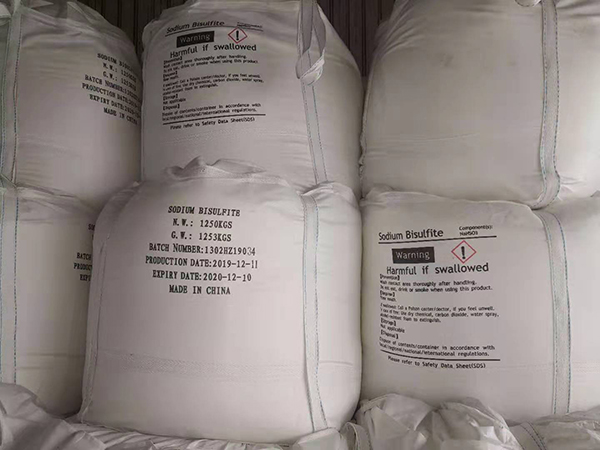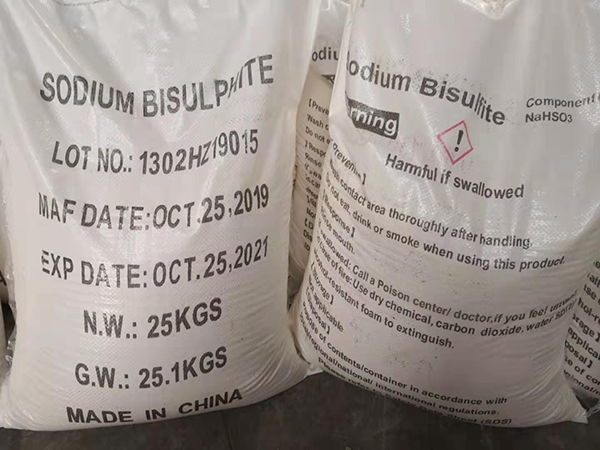Process technology of sodium bisulfite from sodium bisulfite manufacturers
Bisulfite combines with hydrogen ions to obtain sulfurous acid. Sulfurous acid is more acidic than bisulfite. According to "weak acids cannot generate strong acids", it is known that the ability of hydrogen sulfite to bind hydrogen ions ionized by water is weaker than its The ability to ionize hydrogen ions, so hydrogen sulfite will ionize to generate hydrogen ions, so that the solution is acidic.
The role of sodium bisulfite is:
Used for bleaching cotton fabrics and organic matter.
2. Used as a reducing agent in dye, paper, leather, chemical synthesis and other industries.
3. Intermediates used in the pharmaceutical industry for the production of analgin and aminopyrine.
4. Food grade products are used as bleaching agents, preservatives and antioxidants.
5. Used for the treatment of chromium-containing wastewater, and used as an electroplating additive.

Sodium bisulfite is a weak reducing agent and cannot be used as a strong reducing substance. In the printing and dyeing industry, it is used as a deoxidizer and bleaching agent for various cotton fabrics, which can improve the whiteness of the cooked products. So how is sodium bisulfite produced?
1. The raw material liquid sulfur enters the refined sulfur pool. The refined sulfur pool is a square container with 12 sets of heating coils, which are heated to a liquid state with good fluidity under the steam of 0.3-0.4MPa (the melting temperature of sulfur is 118.9 Degree), the temperature of the refined sulfur bath is controlled within the range of 135-145 degrees;
2. Liquid sulfur incineration: The liquid sulfur incineration is carried out in a sulfur furnace. The sulfur furnace is a garden type horizontal furnace with three partition walls in the middle, lined with refractory bricks and insulation bricks. The air is centrifuged from the front of the furnace. Sulfur is pressurized by a sulfur pump to about 0.5MPa, and it is centrifugally sprayed into the furnace with a high-pressure sulfur spray gun to form a mist and fully mixed with air to burn, generate sulfur dioxide and emit heat, so that the temperature of the furnace gas rises to nearly 900℃ and leaves the sulfur incinerator. Waste heat boiler;
3. Utilization of waste heat: high-temperature furnace gas enters the waste heat boiler, sulfur dioxide furnace gas flows out of the tube, the outside of the tube is boiler water, the boiler water is heated and evaporated into steam, enters the steam drum for steam-water separation, and the water returns to the boiler under the action of 2.5MPa steam Leave the waste heat boiler;
4. Furnace gas cooling: Furnace gas <300℃ leaves the waste heat boiler and enters secondary cooling. It is further cooled to 60℃ through the liner glass tube cooler and enters the water washing tower. After washing and removing impurities, it enters the demister;
5. Absorption of sulfur dioxide: The furnace gas after cooling and demisting enters three absorption towers in series, sprays 17%-22% alkali solution in the tower, and generates sodium bisulfite in the tower when the PH value reaches 3.7- At 4.5 o'clock, the system is transferred to the finished product filter. The finished product filter is a microporous filter tank made of polytetrafluoroethylene. The solution enters and exits from the outside and enters the underground tank. The pump enters the finished product tank for sodium bisulfite and sulfur dioxide in the furnace gas. After absorption by Tower 1#, the absorption rate reaches 100%, and the remaining waste gas is discharged into the air through the exhaust chimney, completing the entire production process.
The above is the production process of sodium bisulfite. Sodium bisulfite will emit harmful gases during the production process, so workers should wear protective equipment and standardize operations to avoid danger.

